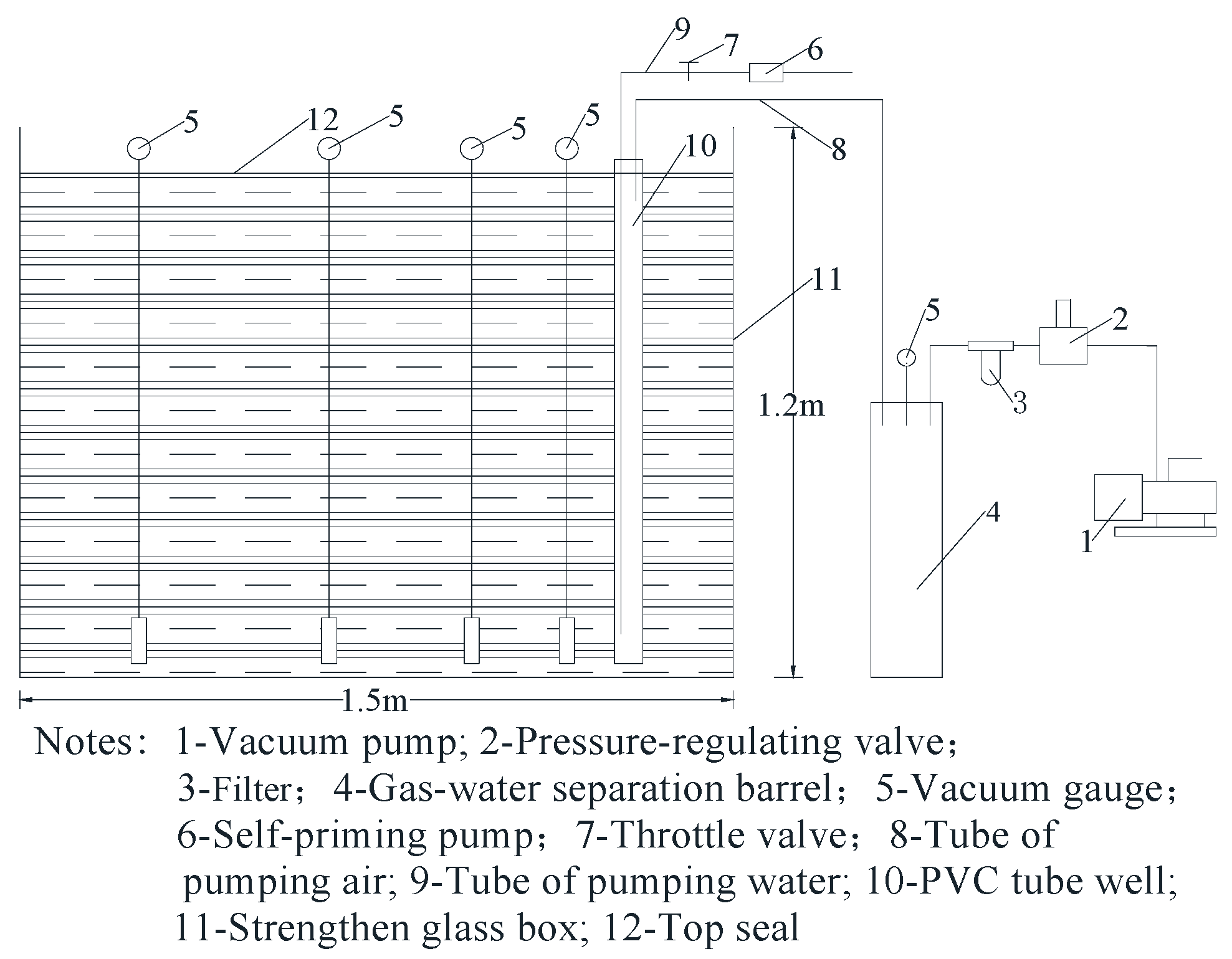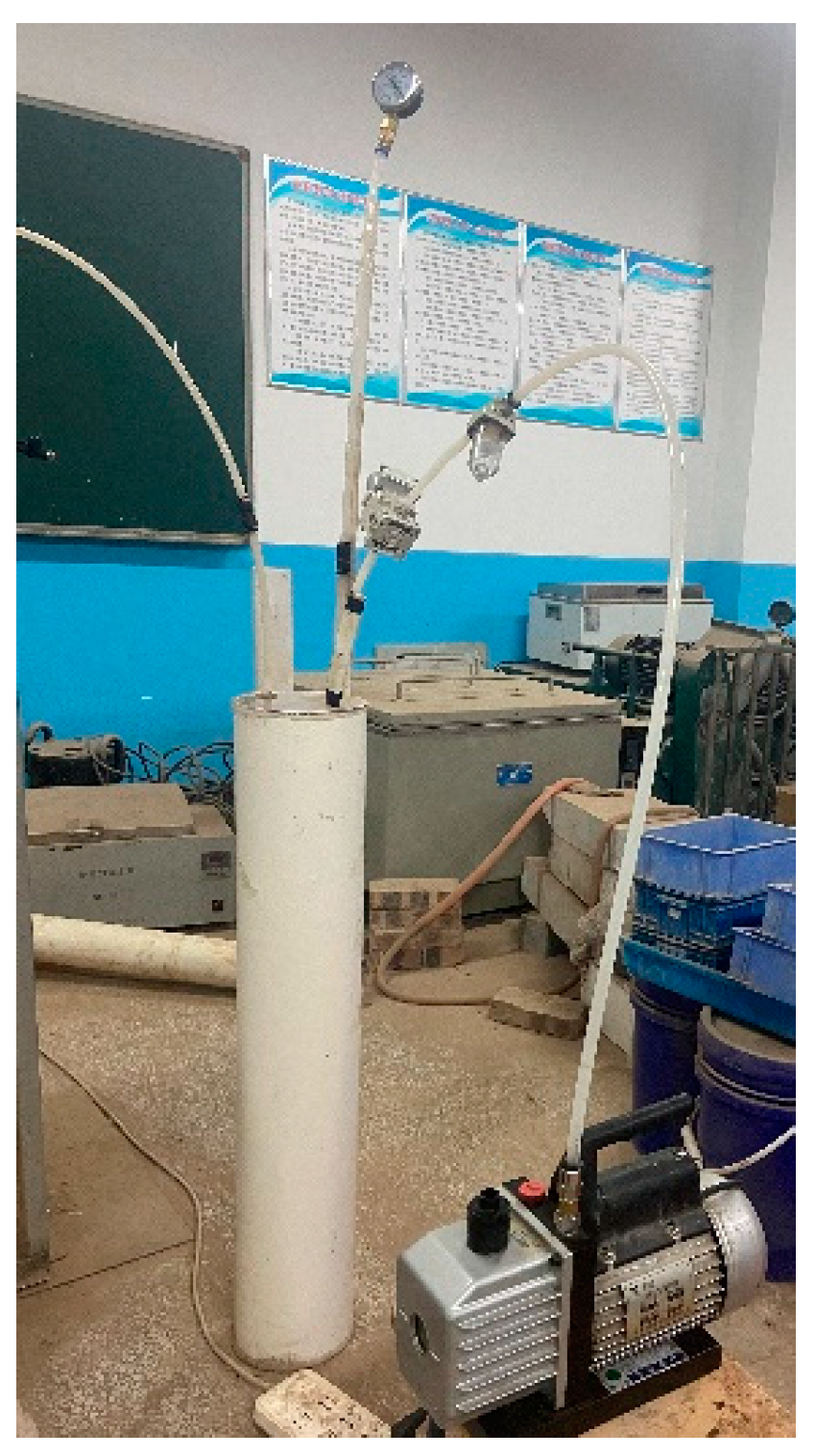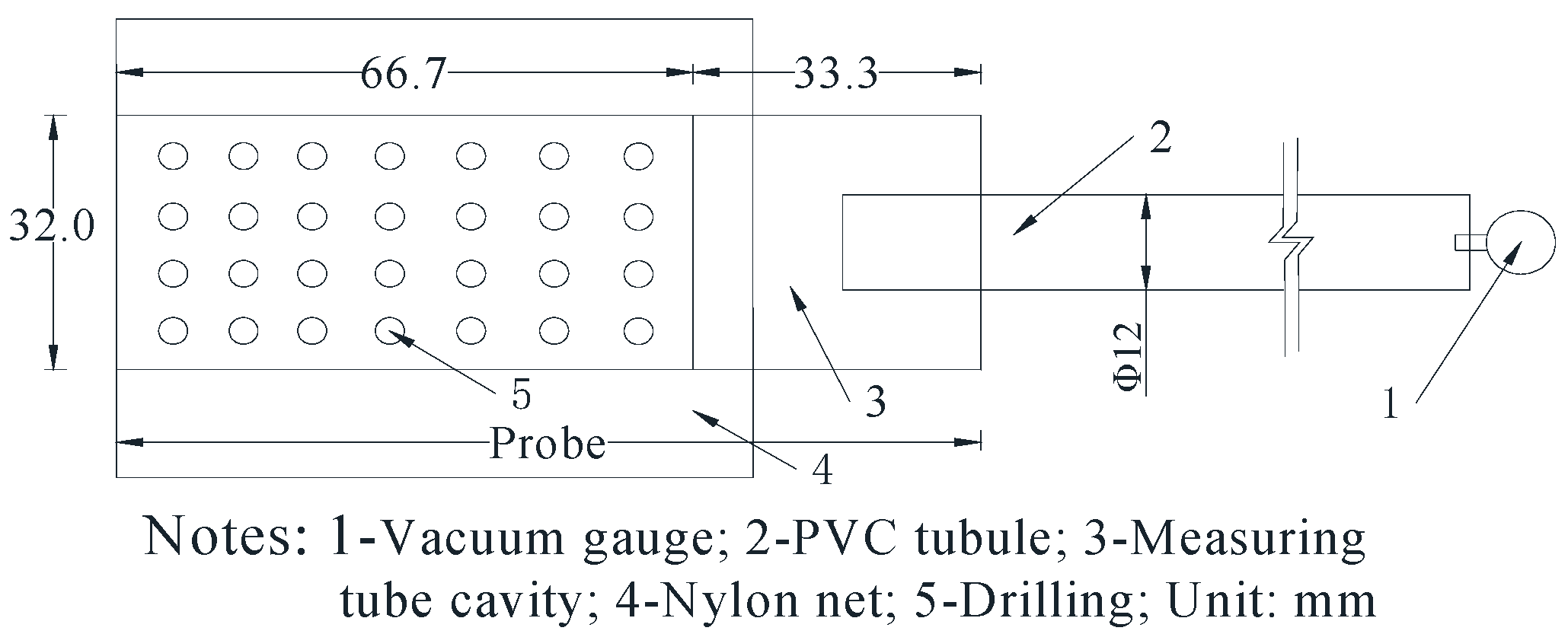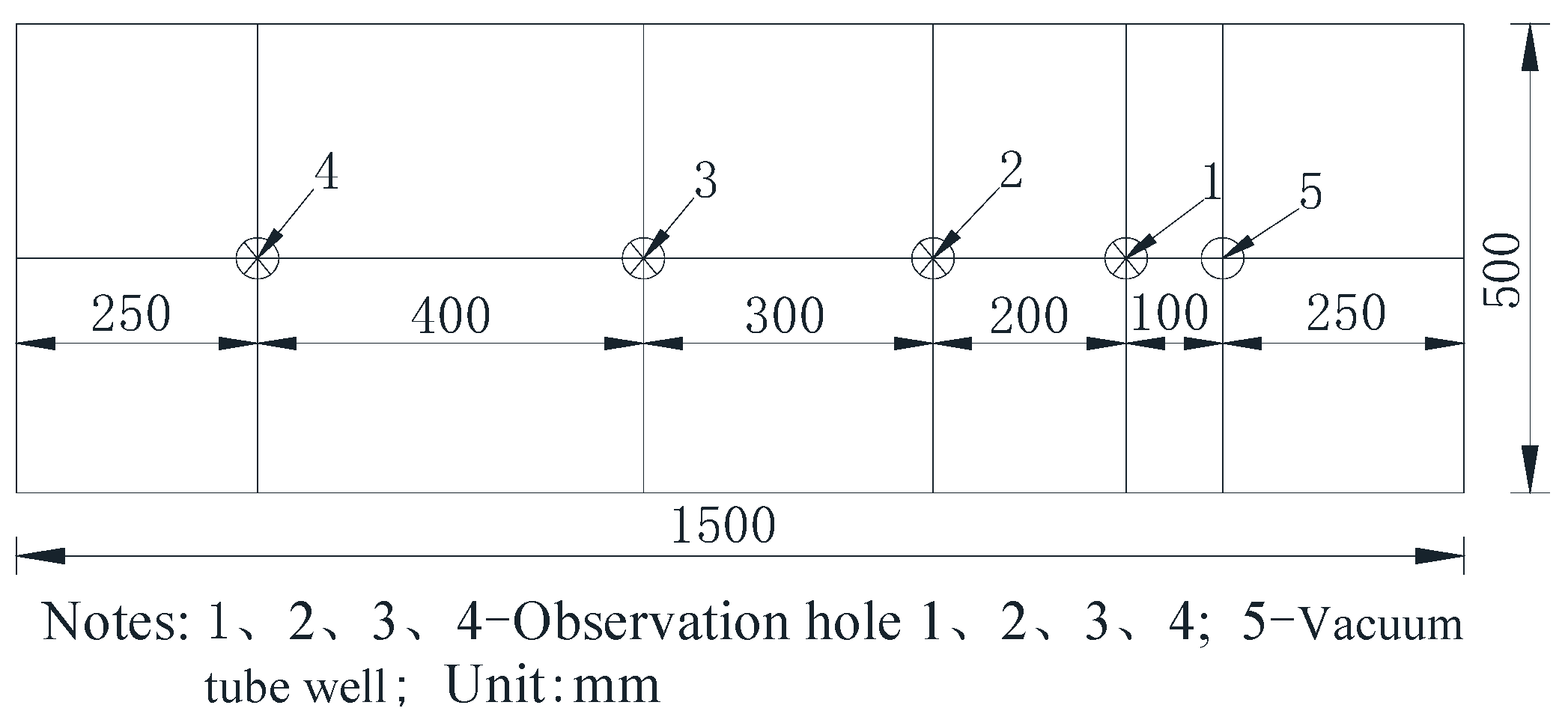Development of Vacuum Tube Well Dewatering Test Device and Study on Vacuum Degree Transfer Law
Abstract
1. Introduction
2. Development of Vacuum Tube Well Dewatering Laboratory Model and Scheme Design
2.1. Development of Model Test Device
2.2. Test Scheme
2.2.1. Test Soil Sample
2.2.2. Test Scheme Design
3. Experiment Results and Analysis
3.1. Effect of Vacuum Value in the Tube Well on the Vacuum Degree Distribution
3.1.1. The Distribution of Vacuum Degree in the Horizontal Direction
3.1.2. The Distribution of Vacuum Degree in the Vertical Direction
3.2. The Influence of Tube Well Diameter on Vacuum Degree Transmission
3.2.1. The Distribution of Vacuum Degree in the Horizontal Direction
3.2.2. The Distribution of Vacuum Degree in the Vertical Direction
3.3. Influence of Tube Well Burial Depth on Vacuum Degree Transfer
4. Conclusions
- (1)
- A laboratory test setup for vacuum tube well dewatering was developed, and the device was composed of six parts: model box, dewatering tube well, water pumping system, air pumping system, measuring system, and sealing system. It effectively solved the problem of poor air tightness and the in-well water entering the vacuum pump. The device’s viability for researching the vacuum degree transfer law in vacuum tube well dewatering was verified after numerous rounds of testing.
- (2)
- With the increase of vacuum value in the well, the radial vacuum degree and vertical vacuum degree have about 14.9~47.7% and 14.9~32.4% increase, respectively, and the range of vacuum field increases. With the outward transmission of the vacuum degree, the transmission attenuation of the radial vacuum degree decreases rapidly and then tends to be stable, and the transmission attenuation of the vertical vacuum degree decreases gradually. When the vacuum value in the well increases, the transmission attenuation of the radial vacuum degree and the vertical vacuum degree increases to a certain extent, this shows that the change of vacuum value in the well will affect the transmission efficiency of the vacuum degree.
- (3)
- The increase in pipe diameter can improve the radial and vertical vacuum degree in the vacuum field, but the effect of this improvement is not good. Its increasing margin is 5.4~11.9% and 2.9~5.2%, respectively. The change in tube diameter will not affect the range of the vacuum field. When the tube diameter increases, the transmission attenuation of the radial vacuum degree initially reduces and then stays constant, whereas the transmission attenuation of the vertical vacuum degree stays the same.
- (4)
- By comparing and analyzing the measured data under different buried depths, it is found that when the buried depth of the tube well increases, the radial vacuum degree, the range of the radial vacuum field, and the transmission attenuation of the radial vacuum degree do not change obviously.
Author Contributions
Funding
Institutional Review Board Statement
Informed Consent Statement
Data Availability Statement
Acknowledgments
Conflicts of Interest
References
- Liu, N.; Wan, Y.H.; Cao, C.Y.; Liu, X.Y. Innovative solutions for layout planning and implementation of a metro station and its accessory structures in mountainous cities, China. Tunn. Undergr. Space Technol. 2022, 129, 104670. [Google Scholar] [CrossRef]
- Zeng, C.F.; Zheng, G.; Xue, X.L.; Mei, G.X. Combined recharge: A method to prevent ground settlement induced by redevelopment of recharge wells. J. Hydrol. 2018, 568, 1–11. [Google Scholar] [CrossRef]
- Cao, C.Y.; Shi, C.H. Analytical procedure for massive water-sealing barriers used in deep excavations considering seepage effect and its application. J. Cent. South Univ. 2022, 29, 2033–2048. [Google Scholar] [CrossRef]
- Zhou, F.C.; Zhou, P.; Li, J.Y.; Lin, J.Y.; Ge, T.C.; Deng, S.M.; Ren, R.; Wang, Z.J. Deformation characteristics and failure evolution process of the existing metro station under unilateral deep excavation. Eng. Fail. Anal. 2022, 131, 105870. [Google Scholar] [CrossRef]
- Wu, Y.X.; Zheng, Q.; Zhou, A.N.; Shen, S.L. Numerical evaluation of the ground response induced by dewatering in a multi-aquifer system. Geosci. Front. 2021, 12, 101209. [Google Scholar] [CrossRef]
- Chen, Z.; Huang, J.T.; Zhan, H.B.; Wang, J.G.; Dou, Z.; Zhang, C.J.; Chen, C.S.; Fu, Y.S. Optimization schemes for deep foundation pit dewatering under complicated hydrogeological conditions using MODFLOW-USG. Eng. Geol. 2022, 303, 106653. [Google Scholar] [CrossRef]
- Zeng, C.F.; Song, W.W.; Xue, X.L.; Li, M.K.; Bai, N.; Mei, G.X. Construction dewatering in a metro station incorporating buttress retaining wall to limit ground settlement: Insights from experimental modelling. Tunn. Undergr. Space Technol. 2021, 116, 104124. [Google Scholar] [CrossRef]
- Hong, C.Y.; Zhang, J.Y.; Chen, W.B. An Integrated Intelligent Approach for Monitoring and Management of a Deep Foundation Pit in a Subway Station. Sensors 2022, 22, 8737. [Google Scholar] [CrossRef]
- He, Y.Y.; Sun, B.L.; Wang, M.N. Study on Stability of Tunnel Surrounding Rock and Precipitation Disaster Mitigation in Flowing Sand Body. Geofluids 2021, 2021, 6043807. [Google Scholar] [CrossRef]
- Zou, B.; Song, C.Y.; Zhang, D.D.; Chen, L.Z.; Chen, B. Numerical simulation of high vacuum dewatering in low permeability soil. J. Harbin Inst. Technol. 2018, 50, 78–83. (In Chinese) [Google Scholar]
- Zhang, G.X.; Mo, H.Y.; Dong, Z.L.; Zhao, J.G. Analysis of relationship between vacuity and pore-water pressure in vacuum preloading. Rock Soil Mech. 2005, 26, 1949–1952. (In Chinese) [Google Scholar]
- Stewart, L. Analytical Solutions for Steady-State Gas Flow in Layered Soils with Field Applications. Groundw. Monit. Remediat. 2022, 42, 35–46. [Google Scholar] [CrossRef]
- Huang, F.; Wang, G. The Influence of Air Injection on Effects of Vacuum Dewatering: Experimental Study on Vacuum-air Injection Dewatering Method. Electron. J. Geotech. Eng. 2012, 17, 2913–2923. [Google Scholar]
- Huang, F.; Lyu, J.G.; Gao, H.; Yu, Z.T. Groundwater Level Distribution in Vacuum Dewatering Method in Phreatic Aquifer. Geofluids 2018, 2018, 8459289. [Google Scholar] [CrossRef]
- Huang, F.; Lyu, J.G.; Wang, G.H.; Liu, H.Y. One-Dimensional Vacuum Steady Seepage Model of Unsaturated Soil and Finite Difference Solution. Math. Probl. Eng. 2017, 2017, 9589638. [Google Scholar] [CrossRef]
- Jia, X.X.; Nie, Q.K.; Wang, Y.H.; Liang, S.Q. Analysis and numerical simulation of vacuum well point dewatering test. Rock Soil Mech. 2014, 35, 607–612+618. (In Chinese) [Google Scholar]
- Vu, V.T.; Yao, L.H.; Wei, Y.J. Laboratory investigation of axisymmetric single vacuum well point. J. Cent. South Univ. 2016, 23, 750–756. [Google Scholar] [CrossRef]
- Zhou, Y.F.; Wang, P.; Shi, L.; Cai, Y.Q.; Wang, J. Analytical solution on vacuum consolidation of dredged slurry considering clogging effects. Geotext. Geomembr. 2021, 49, 842–851. [Google Scholar] [CrossRef]
- Zhu, J.C.; Wen, X.G.; Gong, X.N.; Cen, Y.R. Analysis of factors having effect on distribution of vacuum degrees during soft ground by vacuum drainage preloading. J. Harbin Inst. Technol. 2003, 35, 1399–1401+1404-1408. (In Chinese) [Google Scholar]
- Geng, X.Y.; Buddhima, I.; Cholachat, R. Analytical Solutions for a Single Vertical Drain with Vacuum and Time-Dependent Surcharge Preloading in Membrane and Membraneless Systems. Int. J. Geomech. 2012, 12, 27–42. [Google Scholar] [CrossRef]
- Bao, S.F.; Mo, H.O.; Dong, Z.L.; Chen, P.S.; Qiu, Q.Z. Research on transfer properties and distribution model of negative pressure in fresh hydraulic reclamation muck foundation. Rock Soil Mech. 2014, 35, 3569–3576. (In Chinese) [Google Scholar]
- Zeng, B.; Zhen, Y.; Zhang, D.W.; Meng, T.; Gong, Z.J.; Liu, S.Y. A case study of vacuum tube-well dewatering technology for improving deep soft soil in Yangtze River floodplain. Environ. Earth Sci. 2021, 80, 598. [Google Scholar] [CrossRef]
- Li, L.H.; Wang, Q.; Wang, N.X.; Wang, J.P. Vacuum dewatering and horizontal drainage blankets: A method for layered soil reclamation. Bull. Eng. Geol. Environ. 2009, 68, 277–285. [Google Scholar] [CrossRef]
- Jiang, Y.B.; He, N.; Xu, B.H.; Zhou, Y.Z.; Zhang, Z.L. Model tests on negative pressure distribution in vacuum preloading. Chin. J. Geotech. Eng. 2017, 39, 1874–1883. (In Chinese) [Google Scholar]
- Hu, Y.Y.; Qian, J.L.; Zhang, C.J. Distribution patterns of final negative pressure in vacuum preloading. Chin. J. Geotech. Eng. 2019, 41, 1139–1148. (In Chinese) [Google Scholar]
- Hu, Y.Y. Consolidation solution for sand-drained ground with impeded boundaries under vacuum preloading. Adv. Eng. Sci. 2018, 50, 32–41. (In Chinese) [Google Scholar]
- Khan, A.Q.; Mesri, G. Vacuum distribution with depth in vertical drains and soil during preloading. Geomech. Eng. 2014, 6, 377–389. [Google Scholar] [CrossRef]
- Lyu, H.M.; Shen, S.L.; Wu, Y.X.; Zhou, A.N. Calculation of groundwater head distribution with a close barrier during excavation dewatering in confined aquifer. Geosci. Front. 2021, 12, 791–803. [Google Scholar] [CrossRef]
- Yan, Y.Z. Experimental study on vacuum degree transfer law of soft clay of different grain size grading under vacuum preloading. Port Waterw. Eng. 2010, 10, 109–112. (In Chinese) [Google Scholar]
- Shan, W.C.; Chen, H.E.; Yuan, X.Q.; Ma, W.L.; Li, H. Mechanism of pore water seepage in soil reinforced by step vacuum preloading. Bull. Eng. Geol. Environ. 2021, 2021, 2777–2787. [Google Scholar] [CrossRef]
- Chen, L.; Zhang, H.F.; Li, Z.P.; An, Y.Y.; Li, Y.L. Experimental study on radial consolidation of soil around drainage plate. Chin. J. Geotech. Eng. 2016, 38, 163–168. (In Chinese) [Google Scholar]

















| Project | Description | |
|---|---|---|
| AIR pumping system. | Vacuum pumping | Vacuum pumping using Shanghai over the FY-1.5A vacuum pump. The vacuum pump provides a stable vacuum for the tube well. Its vacuum degree can be stabilized at 85~90 kPa. |
| Gas and water separator | Both ends of the PVC pipe are sealed with PC plates, and the vents and vacuum surface joints are reserved. It can effectively prevent the water in the tube well from being sucked into the vacuum pump due to excessive suction and reduces damage to the vacuum pump. | |
| Pressure-regulating valve | It can make the vacuum value in the tube well reach 40 kPa, 60 kPa, and 80 kPa, respectively. | |
| Filter | Prevent impurities from entering the vacuum pump and affecting its working efficiency. | |
| Water pumping system | Extraction pump | The flow rate and suction range of the self-priming pump are 5 L/min and 1.5 m, respectively. |
| Pumping water filter | It can prevent fine soil particles from entering the pumping pipe to block the self-priming pump. | |
| Flow control valve | Control pumping flow. | |
| Measuring system | Vacuum gauge | Its range is −0.1~0 MPa. |
| PVC tubule | Its diameter is 12 mm. It is connected to the vacuum gauge by a card sleeve. It is connected to the vacuum degree test probe with professional PVC glue. | |
| Vacuum degree probe | The soil fluid cannot easily interchange when the opening portion is too short, which makes the vacuum gauge susceptible to the no-reading phenomenon. The open section’s length was set to be 2/3 of the entire probe length after numerous experiments (66.7 mm). |
| Strata Name | Thickness/m | Moisture Content w/% | Void Ratio e/% | Saturation sr/% | Permeability Coefficient/10−6 cm/s | Constrained Modulus Es/MPa | |
|---|---|---|---|---|---|---|---|
| Level | Vertical | ||||||
| Clayey Silt | 16.23 | 22.0 | 0.648 | 91.5 | 32.4 | 28.9 | 12.5 |
| Working Condition | Vacuum Value/kPa | Hole Diameter/mm | Depth of Embedment/m | Buried Depth of Measuring Tube/m |
|---|---|---|---|---|
| 1 | 40 | 40 | 1.1 | 1.1 |
| 2 | 60 | 40 | 1.1 | 1.1 |
| 3 | 80 | 40 | 1.1 | 1.1 |
| 4 | 40 | 50 | 1.1 | 1.1 |
| 5 | 60 | 50 | 1.1 | 1.1 |
| 6 | 80 | 50 | 1.1 | 1.1 |
| 7 | 40 | 63 | 1.1 | 1.1 |
| 8 | 60 | 63 | 1.1 | 1.1 |
| 9 | 80 | 63 | 1.1 | 1.1 |
| 10 | 60 | 40 | 0.7 | 0.7 |
| 11 | 60 | 50 | 0.7 | 0.7 |
| 12 | 60 | 63 | 0.7 | 0.7 |
| 13 | 60 | 40 | 0.9 | 0.9 |
| 14 | 60 | 50 | 0.9 | 0.9 |
| 15 | 60 | 63 | 0.9 | 0.9 |
| 16 | 40 | 40 | 0.7 | 0.7 |
| 17 | 40 | 40 | 0.9 | 0.7 |
| 18 | 40 | 40 | 1.1 | 0.7 |
| 19 | 60 | 40 | 0.9 | 0.7 |
| 20 | 60 | 40 | 1.1 | 0.7 |
| 21 | 80 | 40 | 0.7 | 0.7 |
| 22 | 80 | 40 | 0.9 | 0.7 |
| 23 | 80 | 40 | 1.1 | 0.7 |
| Working Condition | Vacuum Value/kPa | Hole Diameter/mm | Depth of Embedment/m | Buried Depth of Measuring Tube/m |
|---|---|---|---|---|
| 1 | 40 | 40 | 1.1 | 0.9 |
| 2 | 40 | 50 | 1.1 | 0.7 |
| 3 | 40 | 50 | 1.1 | 0.9 |
| 4 | 60 | 50 | 1.1 | 0.7 |
| 5 | 60 | 50 | 1.1 | 0.9 |
| 6 | 80 | 50 | 1.1 | 0.7 |
| 7 | 80 | 50 | 1.1 | 0.9 |
| 8 | 40 | 63 | 1.1 | 0.7 |
| 9 | 40 | 63 | 1.1 | 0.9 |
| 10 | 60 | 63 | 1.1 | 0.7 |
| 11 | 60 | 63 | 1.1 | 0.9 |
| 12 | 80 | 63 | 1.1 | 0.7 |
| 13 | 80 | 63 | 1.1 | 0.9 |
Publisher’s Note: MDPI stays neutral with regard to jurisdictional claims in published maps and institutional affiliations. |
© 2022 by the authors. Licensee MDPI, Basel, Switzerland. This article is an open access article distributed under the terms and conditions of the Creative Commons Attribution (CC BY) license (https://creativecommons.org/licenses/by/4.0/).
Share and Cite
Yu, Y.; Tang, J.; Fan, L.; Guo, C.; Zhang, J.; Yang, J. Development of Vacuum Tube Well Dewatering Test Device and Study on Vacuum Degree Transfer Law. Sustainability 2022, 14, 16693. https://doi.org/10.3390/su142416693
Yu Y, Tang J, Fan L, Guo C, Zhang J, Yang J. Development of Vacuum Tube Well Dewatering Test Device and Study on Vacuum Degree Transfer Law. Sustainability. 2022; 14(24):16693. https://doi.org/10.3390/su142416693
Chicago/Turabian StyleYu, Yongqiang, Jinzhao Tang, Lidan Fan, Cong Guo, Jiyun Zhang, and Jie Yang. 2022. "Development of Vacuum Tube Well Dewatering Test Device and Study on Vacuum Degree Transfer Law" Sustainability 14, no. 24: 16693. https://doi.org/10.3390/su142416693
APA StyleYu, Y., Tang, J., Fan, L., Guo, C., Zhang, J., & Yang, J. (2022). Development of Vacuum Tube Well Dewatering Test Device and Study on Vacuum Degree Transfer Law. Sustainability, 14(24), 16693. https://doi.org/10.3390/su142416693






